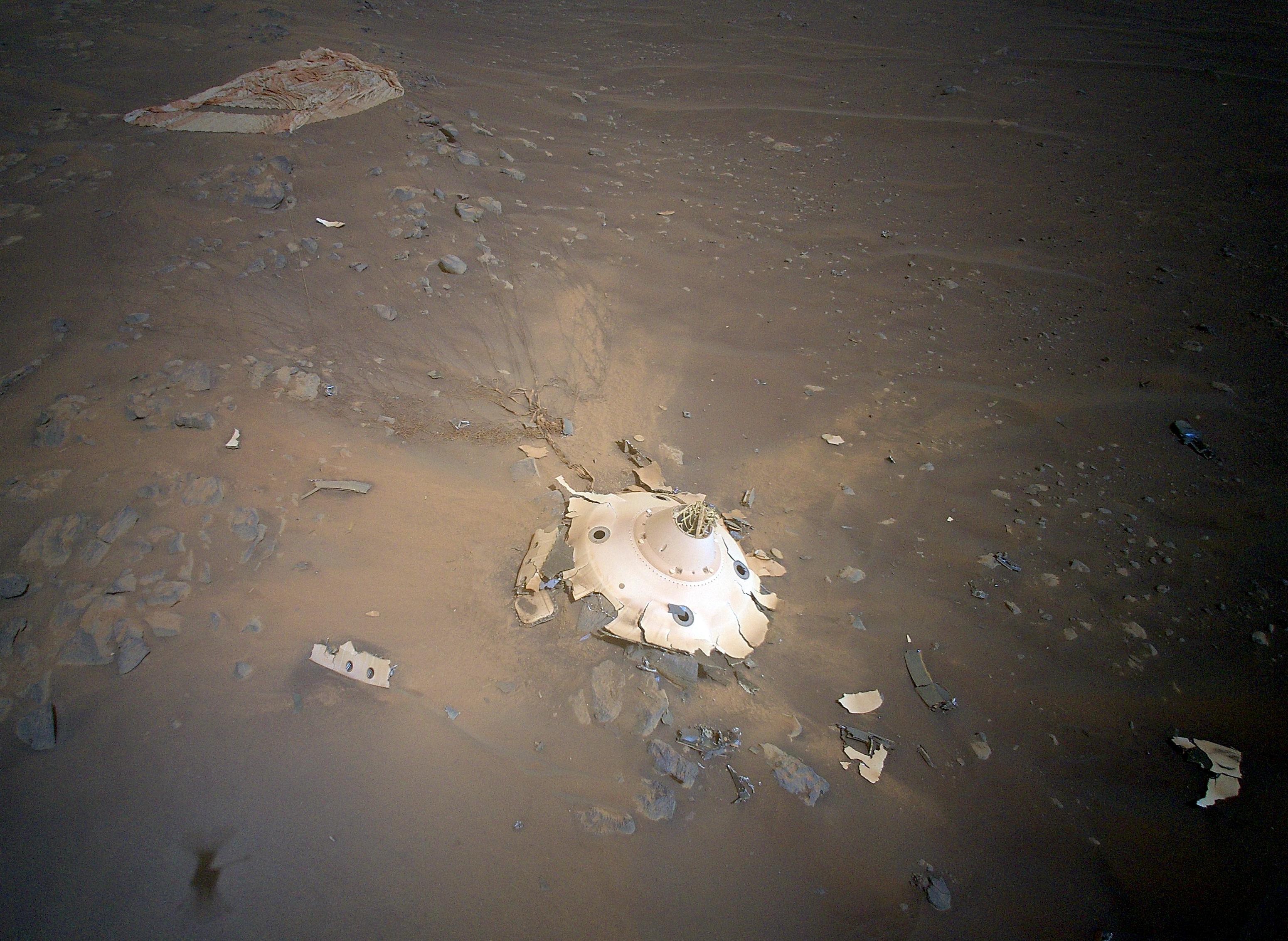
NASA's Ingenuity Mars helicopter continues to give us Red Planet views we've never seen before.
During its most recent flight, which occurred on April 19, the 4-pound (1.8 kilograms) Ingenuity photographed the parachute and backshell that helped it and NASA's Perseverance rover land inside the Red Planet's Jezero Crater on Feb. 18, 2021.
This was no chance sighting. The Ingenuity team was asked to try and image Perseverance's landing gear to aid the joint NASA-European Space Agency Mars sample-return project, which aims to haul the material that Perseverance collects to Earth, perhaps as early as 2033.
Related: 1 year later, Ingenuity helicopter still going strong on Mars
"Perseverance had the best-documented Mars landing in history, with cameras showing everything from parachute inflation to touchdown," Ian Clark of NASA's Jet Propulsion Laboratory (JPL) in Southern California, a former Perseverance systems engineer and now the Mars Sample Return ascent phase lead, said in a statement Wednesday (April 27).
"But Ingenuity's images offer a different vantage point," Clark added. "If they either reinforce that our systems worked as we think they worked or provide even one dataset of engineering information we can use for Mars sample return planning, it will be amazing. And if not, the pictures are still phenomenal and inspiring."
The conical backshell helped Perseverance — with Ingenuity tucked in its belly — survive the long journey from the Red Planet to Earth, as well as the brief but scorching trip through Mars' atmosphere. The mission's supersonic parachute, stretching 70.5 feet (21.5 meters) wide, was the largest ever deployed on Mars. It dramatically slowed the descent of the rover, which was ultimately lowered to Jezero's floor on cables by a rocket-powered sky crane.
Get the Space.com Newsletter
Breaking space news, the latest updates on rocket launches, skywatching events and more!
The backshell and parachute did their job well, as the good health of Perseverance and Ingenuity show. And initial analyses of the new Ingenuity photos suggest that the landing gear held up very well despite the tremendous stresses they endured. (The backshell is in pieces, but that's unsurprising given that it hit the Martian surface at about 78 mph, or 126 kph, on landing day.)
For example, "the backshell's protective coating appears to have remained intact during Mars atmospheric entry. Many of the 80 high-strength suspension lines connecting the backshell to the parachute are visible and also appear intact," JPL officials wrote in the same statement.
And, though just one-third of the chute is visible in Ingenuity's images, "the canopy shows no signs of damage from the supersonic airflow during inflation," JPL officials added in the statement. "Several weeks of analysis will be needed for a more final verdict."
During the 159-second-long April 19 flight, Ingenuity took 10 photos of the backshell and parachute from a variety of perspectives. The helicopter traveled a total of 1,181 feet (360 meters) on the sortie, flying at an altitude of 26 feet (8 m), JPL officials said.

"To get the shots we needed, Ingenuity did a lot of maneuvering, but we were confident because there was complicated maneuvering on flights 10, 12 and 13," Håvard Grip, chief pilot of Ingenuity at JPL, said in the same statement.
The flight was Ingenuity's 26th on the Red Planet, and it occurred on the one-year anniversary of its history-making first Martian sortie.
Ingenuity is a technology demonstration, originally tasked with a five-flight mission designed to show that aerial exploration is possible on Mars. The rotorcraft is now operating on an extended mission, pushing the boundaries of Red Planet flight and serving as a scout for the life-hunting, sample-collecting Perseverance.
Perseverance recently reached the remnants of a river delta that existed on Jezero's floor billions of years ago. The rover team is excited to study and sample the area, which may hold evidence of ancient Red Planet life. And Ingenuity, which is not quite there yet, will be a big part of this effort.
"Upon reaching the delta, Ingenuity’s first orders may be to help determine which of two dry river channels Perseverance should climb to reach the top of the delta," JPL officials wrote in the statement.
"Along with route-planning assistance, data provided by the helicopter will help the Perseverance team assess potential science targets," they added. "Ingenuity may even be called upon to image geologic features too far afield for the rover to reach or to scout landing zones and sites on the surface where sample caches could be deposited for the Mars Sample Return program."
Mike Wall is the author of "Out There" (Grand Central Publishing, 2018; illustrated by Karl Tate), a book about the search for alien life. Follow him on Twitter @michaeldwall. Follow us on Twitter @Spacedotcom or on Facebook.
Join our Space Forums to keep talking space on the latest missions, night sky and more! And if you have a news tip, correction or comment, let us know at: community@space.com.

Michael Wall is a Senior Space Writer with Space.com and joined the team in 2010. He primarily covers exoplanets, spaceflight and military space, but has been known to dabble in the space art beat. His book about the search for alien life, "Out There," was published on Nov. 13, 2018. Before becoming a science writer, Michael worked as a herpetologist and wildlife biologist. He has a Ph.D. in evolutionary biology from the University of Sydney, Australia, a bachelor's degree from the University of Arizona, and a graduate certificate in science writing from the University of California, Santa Cruz. To find out what his latest project is, you can follow Michael on Twitter.









